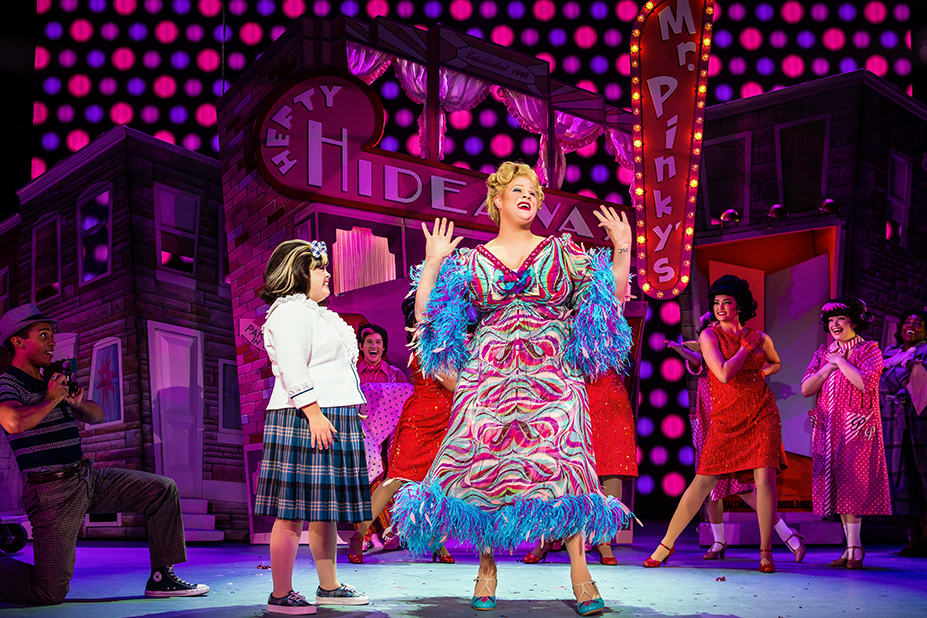Theater review: ‘Hairspray’ joins vibrant visuals, charismatic performances in dazzling show

Niki Metcalf (left) and Andrew Levitt (right) play Tracy and Edna in “Hairspray.” The musical will run until May 21 at the Dolby Theatre. (Courtesy of “Hairspray”)
“Hairspray”
May 2 - May 21
Dolby Theatre
Price Varies

By Talia Sajor
May 9, 2023 1:46 p.m.
This post was updated May 15 at 2:27 p.m.
“Hairspray” is stylishly welcoming audiences to the ’60s.
The nicest kids in town will be dancing on the Dolby Theatre stage until May 21. With a polished ensemble featuring alumnus Joi D. McCoy as Little Inez, “Hairspray” follows plus-sized teen Tracy Turnblad (Niki Metcalf) as she endures the repercussions of becoming an overnight celebrity as a dancer on “The Corny Collins Show” in a segregated 1960s Baltimore. Through vivacious creative and casting decisions, the musical flourishes in immersing viewers in the vibrancy and grooviness of the decade.
Throughout both acts, the colorful set brought about classic designs straight out of the ‘60s with abstract circular patterns and vintage fonts. The costuming, while exaggerated, also stood out as an alluring homage to the decade. Although the ensemble wore cohesive styles, including shift dresses and polo shirts, there were still distinct details that separated the white students from the Black students, aiding its overall message and realism of the racism that permeated during the time.
[Related: Theater review: Modernized ‘Mean Girls’ delivers entertainment but proves the limit does exist]
For example, characters such as the spoiled Amber Von Tussle (Ryahn Evers) and the rest of “The Corny Collins Show” dancers had a more elaborate wardrobe with a brighter, pastel color palette. On the other hand, Little Inez, her brother Seaweed (Charlie Bryant III) and the rest of the Black dancers donned simpler, earth-toned pieces.
Considering “Hairspray” centers entirely on dancing, it is no surprise that the choreography exploded with lively vigor, and every single cast member exuded exuberant charisma with each movement. Particularly in act one’s ensemble numbers – namely “Good Morning Baltimore,” “The Nicest Kids in Town” and “Welcome to the 60’s” – the entire company grooved as one tight-knit unit using moves reminiscent of the period, alongside the period-appropriate sets and costumes, eliciting Tracy’s love for dancing and the beauty of the decade’s aesthetic.
Since the musical takes place during the dance performances at “The Corny Collins Show,” the lighting design also served as a successful tool in distinguishing scenes with an overall realistic feel of the television program. For instance, televised numbers flashed intense, saturated white lights that masterfully switched to a more natural, muted hue when the cameras were cut.
As for the performance, the entire cast stood their ground, especially the wicked, racist Velma Von Tussle (Addison Garner), awkward Penny Pingleton (Emery Henderson) and suave Corny Collins (Billy Dawson). But the true scene-stealers ran in the bloodline of the Turnblad family. Metcalf’s presence shined through both her dulcet vocals and spirited dancing, while Ralph Prentice Daniel stole hearts as her gentle and supportive father, Wilbur.
[Related: ‘The Lonely Few’ redefines audience-performer relations for high-energy musical]
Although, the glue that held the family together was Andrew Levitt, who played matriarch Edna Turnbland. No matter his scene partner, Levitt ignited electrifying chemistry and fell naturally into the dynamic emotions of the character. He was successfully able to balance the duality of the character by asserting himself as the tender and caring mother toward Tracy, and the insecure but loving wife of Wilbur, all while maintaining impeccable comedic timing.
While act one radiated a contagious amount of energy, act two unfortunately failed to live up to the same level, particularly in the final few scenes. With the various subplots interlaced – the attempts to integrate “The Corny Collins Show,” the dismantling of the Von Tussle tyranny and various romantic affairs – the loose ends felt lazily tied together as the show came to a close, a testament to the original 1988 movie the musical was based on. Furthermore, having a white protagonist serve as the central leader in a fight against racism and segregation felt like another dated use of the white savior trope.
Nonetheless, “Hairspray” was a production that will have audiences begging to not stop the beat.

